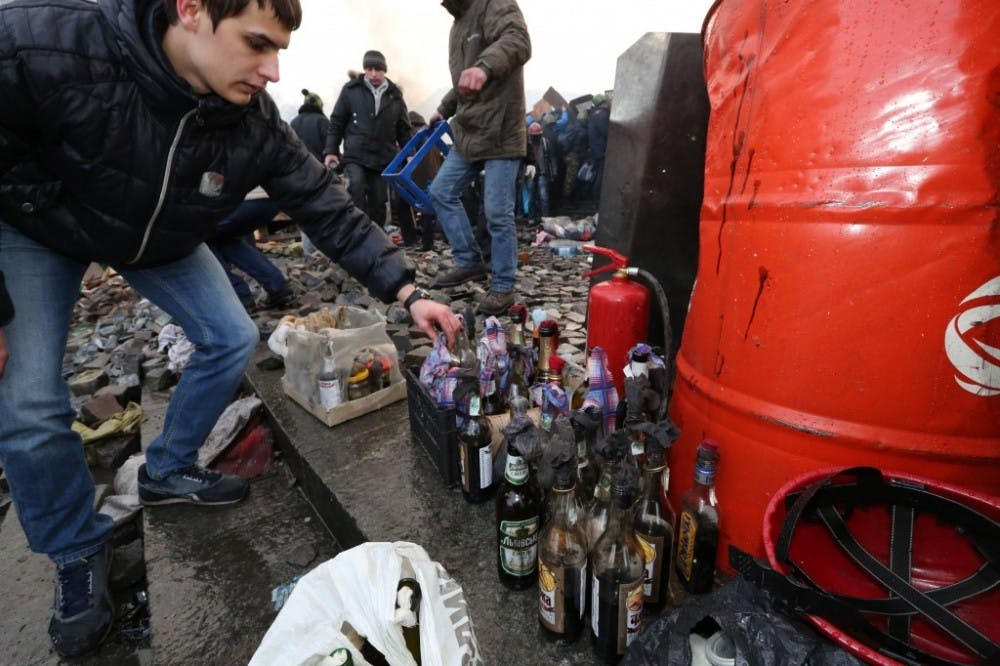After more than two months of protests in Kiev, fighting has surged again, leaving more than 100 people killed since the morning of Thursday Feb. 20. More than 500 people have been injured, and the fighting shows no signs of ceasing. These numbers come from the protestors’ chief medical officer. Kiev’s medical examiner puts the death toll at 67. The fighting began just hours after a truce was declared.
Protest leaders estimate around 100 people from their side have been killed so far, while government officials say 67 policemen have been taken hostage by the protesters.
This round of fighting broke out Thursday morning when protesters attacked police lines outside of parliament.
Timeline of protests
The protests began at the end of November when Ukrainian president Viktor Yanukovych agreed to forgo ties with the European Union, focusing instead on a closer relationship with Russia, the nation that controlled Ukraine for many years when Ukraine was a part of the Soviet Union.
Yanukovych refused to sign a free-trade agreement in a move that shocked and angered many Ukrainians. Yanukovych has a lot of support in the eastern (i.e. Russian) side of the country. The pro-westerners of the country demanded Yanukovych reverse his decision, which he did not. Protesters then began a two-month occupation of Kiev’s government buildings.
The rallies were peaceful for the most part. Four people were killed in two months, but violence erupted earlier this week.
Protest leaders agreed to vacate Kyiv City Hall on Monday Feb. 17 in exchange for the release of all of their prisoners. One day later, fighting broke out, killing 26 people and injuring nearly 100 in a matter of hours. A truce was called on Wednesday, but fighting broke out again Thursday morning.
Thursday’s clash
Video footage from the Associated Press has emerged that shows alleged snipers picking off several unarmed protesters. Protesters told USA Today that they had no guns with them.
Olga Bogomolets, a doctor treating protesters told CNN she believed the protesters had been targeted by professional snipers.
“They didn’t give any chance to doctors, for us, to save lives,” Bogomolets said.
A government statement said the protesters initiated the conflict.
"Protesters broke the truce," the statement from Yanukovych's office said."The opposition used the negotiation period to buy time, to mobilize and get weapons to protesters."
The government did not deny using firearms, saying that it was in “legitimate self-defense.”
East/West divide
Other countries are stepping in. A meeting took place between Yanukovych and ministers from Poland, Germany and France Thursday morning. The ministers then met with the opposition.
Putin is sending an envoy to Ukraine to mediate between the government and the opposition. This comes at the request of Yanukovych.
Ukraine is being used as a power play between Russia and the West. Both sides have made vigorous efforts to draw in Ukraine, but neither side condones the violence that is happening.
Russia offered Ukraine a 15 billion dollar bailout to convince Yanukovych to not sign Europe’s trade deal in November, but so far they have only provided 3 billion dollars.
German Chancellor Angela Merkel said on Wednesday that she and Russian president Vladimir Putin had spoken on the phone and were planning to do “everything necessary to keep violence in Ukraine from getting worse.” Merkel urged Putin to accept the EU’s offer of help in crisis mediation.
The United States said that, if violence continues, they will not tolerate it and will step in.
With the West having zero support for Yanukovych, and the East supporting close ties to Russia and depending on them for trade, the divide will likely only widen and violence will continue to escalate.


